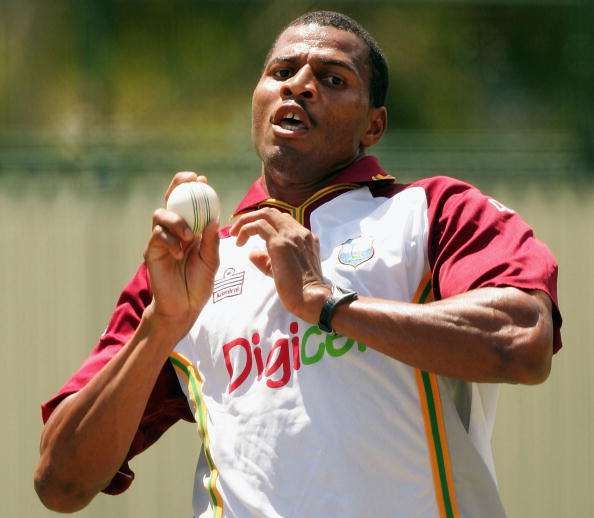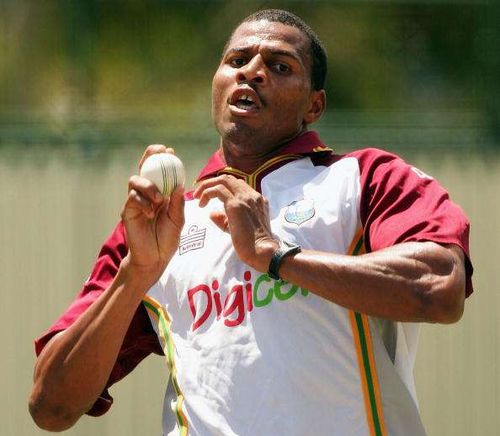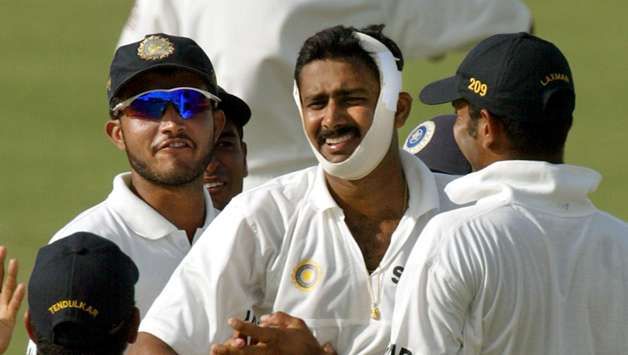
Interview with Mervyn Dillon: "If a fast bowler said he never wanted to hurt the batsman, he would be lying"
With a high arm action that resembled the great Courtney Walsh and with the ability to move the ball into the right-hander, Mervyn Dillon was a force to reckon with in the West Indian bowling line-up of the early 2000s. He was one of the stars of the home team during India’s tour to the Caribbean in 2002, ripping the heart out of the famed Indian batting line-up with 23 victims in five Tests at an average of 27.21. One of his vicious bouncers found its way into Anil Kumble’s helmet and broke the latter’s jaw.
A lot of water has passed under the bridge since then, and Kumble is back in the Caribbean, albeit in a coaching role. Sportskeeda caught up with Dillon, and went into reminiscing mode, remembering the 2002 series and discussing the current scenario in the West Indies.
What is your most memorable highlight of the 2002 West Indies-India series?
The entire tour was a fascinating one. If you look at West Indies, and their record at home, even though we had lost a couple of series, and if you look at the Indian batting line up which would go down as one of the best in the game, with players like Tendulkar, Ganguly, Laxman, it was an interesting series, and very competitive. There are some areas where I could point to, but I had fond memories in general.
I remember, when we won the Test match in Jamaica, the rains came just after the match ended. It was really amazing. That is one incident that really stands out for me.
You were suddenly the leader of the pace attack. What did you do differently?
I would say the team itself was together. We had a captain who believed in us and gave us that responsibility, and I think that is where leadership comes in. He allowed you to express yourself, to set your own fields and attack, that itself was a plus to us. There are great leaders out there, and they let you do things, rather than trying to dictate. Things fell in place for us, the bowlers and batters came together. They(India) had a really good team, so it was a great thing coming on top after going down in Trinidad.
The injury to Anil Kumble was a much-talked-about incident. What goes through a bowler’s head after such a thing?
If you talk to most people who have played against Anil, they will tell you what a competitor he was. We used to regard him as one of the few remaining old warriors of the game.
I could be politically correct and say that I didn’t want to hurt him, or that it wasn’t the plan, but deep down as a fast bowler, when you bowl a bouncer, the ideal scenario will be to get him out. The next best thing will be to hit him, and being honest, we realised Anil would be going to Jamaica, where the wickets would suit him, and I would be lying if I say that trying to get rid of him wasn’t part of the plan.
Being real about it, and you ask any fast bowler, if he says he never wanted to hurt the batsman, that would be a lie.
There were a number of great batsmen whom you played against. Who stands out as the most difficult batsman to bowl to?
There are a few players, against who you knew you had to be at the top of your game because the minute you are off-line or length, they would get rid of you. My top of the list would be Adam Gilchrist, with Virender Sehwag coming a close second.
Gilchrist would take your best ball, and put it behind point for four, which was demoralising. Sehwag was pretty much the same. They didn’t have the best footwork in the world, but they fired more often than not. I played against Aravinda de Silva as well, although not that much, but he was amazing as well. Matthew Hayden was an imposing figure at the crease, and it was difficult to keep these batsmen quiet.
I am not taking away anything from people like Sachin, and the other greats, but from my experience, these players were the most difficult to bowl at.
West Indies had a great pool of fast bowlers in their period of domination. Why do you feel about it today, and why do you think India doesn’t produce the same kind of bowlers?
One of the things I am very passionate about, and this is where the disappointment comes in, is about the people who manage and run the game. West Indies dominated cricket for 15-20 years, and one of the main reason everyone used to talk about us was our fast bowlers. No doubt, there was always Guyana and Antigua with the slow pitches where the pacers had to work hard, but then there was Trinidad, with the sideways movement, as well as Barbados and Jamaica that you looked forward to.
Today, looking at the placid nature of wickets around the Caribbean, I feel sorry for the younger generation of fast bowlers. We have a lot of talented, fit and athletic pacers, but there is no help for them. If you look at the percentage of spin that is bowled in our domestic cricket, and if you compare it to that of the fast bowlers, you will find the answer.
It is pretty similar in India with the wickets. As a youngster, it is difficult to do something in those conditions. I have respect for bowlers like Javagal Srinath and the others who came through that system. From an administrative point of view, we need to look at our wickets, to encourage pacers better and not just make it all about the batsmen.
What would you describe as the most memorable moment of your career?
I wouldn’t say there was one thing that stood out as such, but as a youngster, I didn’t expect getting into a side that had Walsh, Ambrose and Bishop. I was playing with the guys I idolised and saw as superior to me. I wouldn’t say I didn’t have aspirations to play for the West Indies, but I always saw them as different from me. Hence, it was a privilege for me to represent such a proud nation as far as cricket is concerned, and to get to play alongside Brian Lara, Courtney Walsh, Curtly Ambrose, Carl Hooper and Jimmy Adams.
I also consider the 2004 Champions Trophy win as one of the highlights. Although I got injured midway, it was definitely a big thing for us.
Speaking about players you looked up to, who were your heroes/idols?
Courtney Walsh is definitely someone whom I looked up to and admired. He wasn’t always the star of the show, but worked hard and was the unsung hero. He had a never-say-die attitude; he used to do the donkey work, yet went on to break the record for most Test wickets. The fact that he kept going, that to me was admirable.
Who was the best captain that you played under?
As far as captaincy is concerned, Brian Lara is up there with the best. There is a reason why he is called a genius. If you hear the guy talk, it is amazing how he breaks down the game and deals with it. I can say I have never seen a better tactician, someone who reads the game like him.
There were others like Carl Hooper and Jimmy Adams as well. It is all about bringing the guys together, and I really enjoyed playing under them.
What are your views on the Caribbean Premier League? Will it help promote the game in the country?
Definitely. When you look at the game, and how the crowds continue to grow, it is amazing. There is a Florida leg of the CPL as well. When you look at T20, and American sports, and most sports around the world, T20 has really picked up and become popular. It has brought back a lot of interest in the game. T20 cricket gives you that entertainment value.
However, for me, Test cricket is THE form of the game. T20 has a long future, but it depends on how it is managed and taken forward.
There is so much T20, and it is a good thing that specialists play it round the year and earn good money. But we shouldn't water down the sport by playing too much of it. There are players who are getting a lot of opportunities. Look at David Warner, he started off as a T20 specialist but made a career for himself in Test cricket as well. I always believe it is easier for a person to be taught how to block the ball.
There is a lot of debate about the best batsman in the world, currently. What is your take?
I will answer the question in two parts. In the West Indies, Darren Bravo is one of the most talented batsmen I have seen. I have so much respect for him, and he can go a long way and become one of the greats of the game, he just needs to toughen himself up mentally.
Secondly, from what I see, a lot is talked about players such as Virat Kohli and AB de Villiers, and then there is Hashim Amla as well. I took the other two names, but if you look at Amla, he is not flamboyant like the other two, but he has great numbers, if not better.
I always give special mention to Chris Gayle, simply because, throughout his career, pundits have doubted his game: he doesn’t move his feet much, he plays too fast. But look at his numbers, his records speak for him. As Bravo would say, he is a Champion.
Others like Kieron Pollard and Dwayne Bravo can contribute more as well. In West Indies, we tend to retire players way too early. Australians start their international careers late, we tend to finish them in the 30s. That is something the administration should look at. It is a good thing pushing young players in, and it comes from someone who himself played just two first-class games before getting into the Test team, but we tend to discard players quickly.
We need to sort the problems that have been going between the players and the administration because it has been running on for a long time, and West Indies cricket and cricket, in general, is suffering a lot. It is for the benefit of both that the issues are resolved.
Lastly, what tips would you give to the current crop of fast bowlers?
I happen to follow a bit of the ongoing series, and from what I have noticed, you need that seniority to help the youngsters. If you look right now, Marlon Samuels is probably the most senior person. In the bowling attack, there isn’t anyone experienced to help the likes of Carlos Brathwaite out. There is no shortage of talent, we just need to manage the players better. We should look at the wickets, help the fast bowlers and improve coaching.
That will predict how the game goes forward for us.

